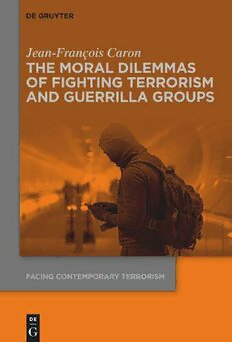
The Moral Dilemmas of Fighting Terrorism and Guerrilla Groups PDF
Preview The Moral Dilemmas of Fighting Terrorism and Guerrilla Groups
Jean-François Caron The Moral Dilemmas of Fighting Terrorism and Guerrilla Groups Facing Contemporary Terrorism Edited by Jean-François Caron Volume 2 Jean-François Caron The Moral Dilemmas of Fighting Terrorism and Guerrilla Groups ISBN 978-3-11-075748-4 e-ISBN (PDF) 978-3-11-075756-9 e-ISBN (EPUB) 978-3-11-075758-3 ISSN 2749-1188 e-ISSN 2749-1196 Library of Congress Control Number: 2022946317 Bibliographic information published by the Deutsche Nationalbibliothek The Deutsche Nationalbibliothek lists this publication in the Deutsche Nationalbibliografie; detailed bibliographic data are available on the internet at http://dnb.dnb.de. © 2023 Walter de Gruyter GmbH, Berlin/Boston Cover image: Lorado / iStock / Getty Images Plus Printing and binding: CPI books GmbH, Leck www.degruyter.com Contents Introduction 1 Chapter 1 The Difficulty of Defining Terrorism 5 Chapter 2 Assessing the Morality of Guerrilla Warfare 30 Chapter 3 How to Combat Terrorism? 54 Chapter 4 The Status of Captured Terrorists 84 Chapter 5 Can Terrorism be Used in Exceptional Circumstances? 99 Conclusion 119 Bibliography 120 Index 127 Introduction MostofuslivingintheWestbecameacquaintedwiththerealityofterrorismasa clearandpresentdangeronlyinthelast20yearsafterthe9/11attackstriggered numerousattacksagainstciviliansbyindividualswhohadpledgedallegianceto AlQaedaortheIslamicStateofIraqandtheLevant(ISIL).Inthisregard,wecan thinkofthe2004attacksinMadrid’scommutertrainsysteminwhich193people diedandaround2,000wereinjured;orsimilarattacksthattookplaceoneyear later in London’s public transport system that killed 56 people and injured an- other784andthe2015Parisattacksthatkilledandinjured130and416innocent people, respectively. However,itwouldbeamistaketoconcludethatterrorismisacontemporary phenomenon.Ashighlightedbythemostfamousanalystofthistypeofpolitical violence,WalterLaqueur,ifweareto thinkofterrorism as distinct fromregular warfare(which is a mistake,but moreon this later), attacks bysmallgroups of irregular fighters against state actors or civilians go back to time immemorial (Laqueur & Wall, 2018, p. 27). As amazing as it sounds, it must be stressed thatdespiteitslongevityandthefactthatithasbeenwidelydiscussed,terrorism remains awidely misunderstood reality.The fact that the international commu- nitystilldoesnotagreeonacommondefinitionofterrorismisprobablythemost obvious testimony in this regard.The primary objective of this book is to shed somelightonthenatureofterrorismbyexplaininghowdistinctiveitisfroman- otherwell-knownformofirregularwarfarethatitistoooftenconfoundedwith, namelyguerrilla. Terrorismisusuallyassociatedwithbarbaricentitiesthathavenoconsider- ationforinnocentpeople’slivesandwhoseactionsareoftenthoughttobeirra- tional and commanded bydivinity.Guerrillawarfare is,for its part, linkedwith groupsthathavemorenobleaims,suchasthosefightingfornationalliberation. Asproofofthisdistinctivemannerofassessingthesetwoformsofpoliticalvio- lence,manyindividualswholedandwereinvolvedinthelatterformofwarfare arenowcelebratedasheroesinmanysocieties¹,whileterroristsdonotsharethe same historical fate (for a reason that is far from being a subjective matter, as I will discuss in this book). However, although tempting and rather common in people’s viewpoint, this manner of distinguishing terrorism from guerrilla byfocusingontheirrationalityoftheformerandthenoblecharacterofthelatter Inthisregard,wecanrefertoMichaelCollinswhoplayedapivotalroleinthecreationofthe Irish Republicandwaspositivelydepicted in the 1996 award-winningbiographical movie, in whichhewaspersonifiedbyactorLiamNeeson. https://doi.org/10.1515/9783110757569-001 2 Introduction ishighlyproblematic.Indeed, historyhasproventhattheresorttoterroristtac- ticshassometimesbeentheresultofawell-thoughtrationaldecisionbygroups thatwerealsofightingfortheirnationalliberation,whilemanygroupsanimated byreligiousbeliefsrefusedtoresorttothistypeofviolence.Inreturn,terrorism was also aprivilegedtacticof non-religiousgroups,whichmakesthe use of ra- tional/irrational, barbaric/noble aims, and religious/non-religious dichotomies inappropriatetoolsindefininganddistinguishingbetweenthesetwotypesofvi- olence. Another mistake would be to limit terrorism as an inherent tactic of non- state actors. There is a common misconception in this regard which is largely the result of the double standards used by states that have given themselves the monopoly over legitimate violence as a mean to always find noble ways of justifying their resort to war in opposition to non-state entities often presented asrogue,criminal,andimmoralintheiraimsandmeansofaction.Additionally, we should not forget that from an etymological perspective the word terrorism derivesfromtheFrenchword‘terreur’whichwasaclearlyaffirmedpoliticaltac- ticusedbyFrenchrevolutionarieslikeRobespierreorSaint-Just,thusmakingita formofviolencethatisnotsolelyrestrictedtonon-stateactors².Furthermore,in thepast,evencontemporarydemocraticstateshaveexplicitlychosentoresortto indiscriminate tactics that aimed at terrorising their enemies, as was the case with WinstonChurchill’sordertohisAirCommandtobombGermancities dur- ingWWII.Consequently,thesecommonmisconceptionscallfor abetter assess- ment of the uniqueness of terrorism and guerrilla warfare. Withtheseclarifications,itwillbeeasiertounderstandtheinherentimmor- ality of terrorism and how it differs from guerrilla warfare.Thus, the apparent moral superiority of the latter over the former should not necessarily lead us toconcludethatresortingtoguerrillaasaformofviolenceisalwaysmorallyac- ceptable.Incontrast,iftheactofkillingcansometimesbejustifiedinthistype ofwarfare,thiscanonlybealast-resortoptionandonlywhenthesituationhas reachedacertainextreme.Asaresult,theco-calledsuperiorityofguerrillaover terrorism doesnotgivecarte blanche to theformerwhenitcomestoviolentac- tions.This type of violence also comes with its own string of moral questions that cannot be ignored.The first two chapters will focus on the distinction be- tween terrorism and guerrilla warfare as well as the moral limits of the latter. Additionally,althoughitmaylooklikeastraightforwardaffairbetweengood andabsoluteevil,thewaragainstterrorismorecomplexandbringsinitswake many ethical dilemmas,that is, a confrontation between two moral categorical Initspeakperiod,laterreurledtotheexecutionofaround40,000peopleinasinglemonth. Introduction 3 imperativesinwhichrespectforonewillinevitablyleadtoviolationoftheother. Asarguedelsewhere(Caron,2014),battlefieldmercykillingisprobablythebest exampleofsuchaclashbetweentwomoralnorms.Indeed,inthesesituations, soldiersareforcedtochoose,ontheonehand,toabidebythemoralobligation not to kill avulnerable human being; and on the other hand, not tolet this in- dividualenduretheterriblesufferingresultingfromwhatappearstobealethal wound.Insuchsituations,whateverthedecisiontakenbysoldiersconfrontedby this dilemma will be, the outcome will necessarily be morally questioned by somewhowillcometobelievethattheother alternativeshouldhaveprevailed. Unfortunately,whenitcomestothesecategoricalmoralimperatives,peoplewho arefacingthemarecaughtina“catch-22”asitisimpossibletohierarchisethem and reach an agreement that one decision is better than the other based on a rational assessment of the situation. Inthecaseofterrorism,Iseethreedilemmasofthissortthatareappearing tobeopposedtostates’obligationstoprotectthelivesoftheircitizens.First,itis the responsibility of states to protect the lives of their citizens that are directly threatened by terrorist organizations. Abiding by this obligation therefore calls foractionontheirpart.Inreturn,asisevidentfromAfghanistanandIraq,fight- ingterrorism seems tocomeat the expense of a disproportionate numberofci- vilians’ lives abroad.This has led authors to argue that Western states simply transfertheriskfromtheirowncivilianstothosewhohavethemisfortuneofliv- ing in countries or areaswhere terrorists are operating.Consequently,this ‘risk transfer’ishighlyproblematicfromamoralperspective(aswellasfromapolit- icalperspectiveasthesemilitaryinterventionswereunabletoeveneradicatethe terrorist threats they were promising to achieve) which seems to be creating a situation where states fighting this sort of threat are condemned to violate a moral imperative no matter what theydecide todo:either wait and let theirci- vilians be killed first by terrorists or transfer that risk to civilians abroad as if ‘their lives’ are less important than‘our lives’. Second,thestatusofcapturedterroristsraisesasimilardilemma.Again,for the sake of respecting their obligation to protect the lives of their civilians, are statesallowedtousemethodsoftortureagainstcapturedterroristswhomaypos- sess sensitive information aboutupcomingattacks? It is not surprising that tor- tureisanendemicrealityinmanyauthoritarianandtotalitarianstates,butthe9/ 11attackshavealsoledLiberalstatestoengageinwhathasbeenlabelledas‘en- hanced interrogation techniques’: a euphemism that poorly hides the fact that thesemethodsarenothinglessthantorture.However,theresorttothesetechni- queshas oftenbeen justifiedthroughthelens ofa‘tickingbomb scenario’,that is,whenastateisfacingaterroristthreatthatcannotbepreventedinaconven- tionalandlawfulmanner.Theethicaldilemmahereisthechoicebetweendoing
